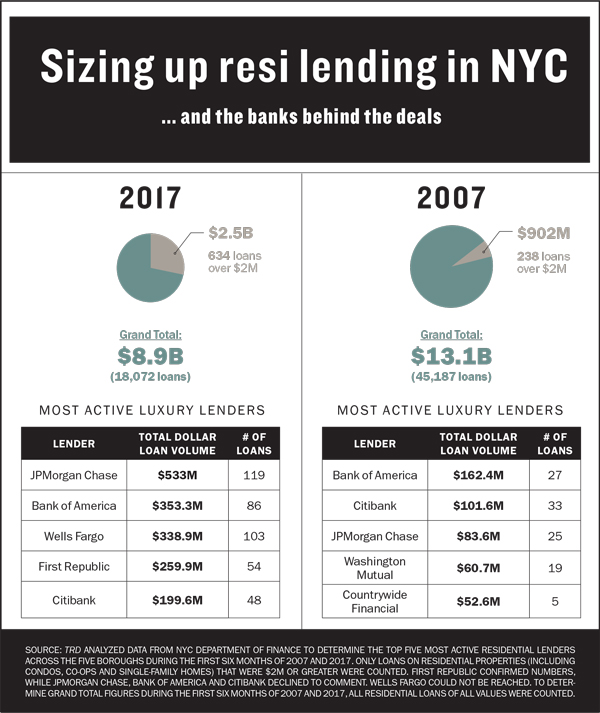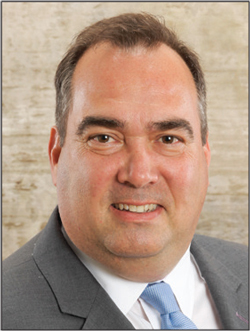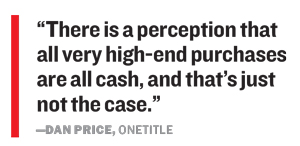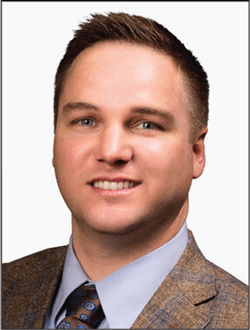 Two years after going into contract on a sky-high condo at 432 Park Avenue, Hong Kong casino mogul Lawrence Ho finally closed on the $65.2 million purchase in late March. The same day, he sewed up a $30.5 million mortgage from Citibank — the second-largest loan to close on a residential property in the five boroughs in the first half of 2017.
Two years after going into contract on a sky-high condo at 432 Park Avenue, Hong Kong casino mogul Lawrence Ho finally closed on the $65.2 million purchase in late March. The same day, he sewed up a $30.5 million mortgage from Citibank — the second-largest loan to close on a residential property in the five boroughs in the first half of 2017.
Wealthy investors like Ho are helping fuel another residential mortgage boom in New York City. While the lending market picked back up in 2013, six years after the subprime mortgage crisis, the recent drop-off in all-cash buyers has created an even larger pool of individuals in need of financing. And despite regulations put in place after the downturn, residential brokers and loan officers told The Real Deal that banks and other financial firms have regained their appetite to lend to qualified borrowers — even as large construction and commercial loans become increasingly rare.
Lenders provided roughly $8.9 billion in residential mortgages in the five boroughs in the first half of 2017, according to an analysis of public records by TRD. While that’s 32 percent below the $13.1 billion originated during the first half of 2007, deal flow has certainly rebounded from the throes of the crisis in 2009, when residential loans plummeted 26 percent in a 12-month period, according to New York University’s Furman Center.
Though few expect residential lending to hit the highs it did just before the crisis, sources say banks and other mortgage underwriters are increasingly willing to work with borrowers to make deals happen.
“We’re very bullish on mortgages,” said Bob Donovan, a senior vice president in Bank of America’s home mortgage division. “We have the money to lend,” he told TRD, noting that the bank leans on home loans as a “core product” to drive market share.
And it’s a two-way street. Buyers lured by the prospect that interest rates will continue to hover below 4 percent are eager to finance deals — whether it’s a $1 million starter apartment or a multimillion-dollar mansion in the sky.
“Money still seems cheap,” said Brown Harris Stevens agent Lisa Lippman, who estimated that 70 percent of her buyers get financing when only about 20 percent of them need it.
“I have a guy buying an apartment for $5.5 million, and he could easily pay cash,” she added, “but he’s getting a 10-year, interest-only mortgage at 2.5 percent.”
The sweet spot
Residential lending across the board is on the upswing, from Manhattan penthouses to three-family homes in the Bronx. Banks underwrote 55,053 mortgages in 2016, a 6 percent increase from the prior year, according to data from the New York City-based title insurer OneTitle. Loan volume totaled $27.3 billion in 2016 — including $18.8 billion worth of new loans and $8.5 billion in refinancings.

Bob Donovan
And though the first half of 2017 saw a 6 percent slip in the number of new mortgages and a 5 percent dip in volume, experts say the market has already started to pick back up.
Stuart Siegel, CEO of Engel & Völkers’ New York City operation, attributed the pause to “price fatigue” in the sales market earlier this year.
“There was a disconnect between price and value,” he said. “Things that are trading now have sold because prices were adjusted. The market is now catching its breath.”
Meanwhile, refinancings are down as interest rates have held steady. “If you already refinanced at 3.5 percent, there wasn’t a lot to do last year,” OneTitle CEO Dan Price pointed out. “There weren’t any dramatic swings in rate if you look at the year as a whole, and rate is really what drives refinancings.”
But a more micro look at New York’s residential financing market shows that there’s a growing demand for large loans. TRD’s analysis found that mortgages above $2 million skyrocketed 177 percent to $2.5 billion during the first half of 2017, up from $903 million ten years prior.
“Under $1 million used to be the sweet spot, but banks have been following the price increases in the city,” said mortgage broker Melissa Cohn of Brooklyn-based FM Home Loans. “The true sweet spot in the market is for properties selling around $2 million or less. The rates are really attractive, and you don’t have to be God to qualify.”
One area of growth in particular has been jumbo (and super jumbo) loans on the city’s priciest residential properties. Those deals are getting done — and they’re actually larger than in years past — despite being disconnected from the market’s bread and butter.
For example, the five largest mortgages for the first half of 2017 totaled $134.7 million. That was up 27 percent year over year and a whopping 241 percent from 2007.
The largest mortgage — for $45 million — was snagged by a mystery buyer who paid $50.9 million for Russian financier Andrey Vavilov’s penthouse at the Time Warner Center. Ho followed with the loan for his 432 Park Avenue condo purchase, followed by an anonymous buyer, who through a corporation dubbed Parklight LLC scored a $24 million mortgage on a $65.6 million pad in the same building. Rounding out the top five were a $19.5 million loan at 30 Park Place and a $15.75 million loan at 56 Leonard Street.
“There is a perception that all very high-end purchases are all-cash, and that’s just not the case,” said Price. “We certainly see a healthy number of high-end buyers who finance a portion of the transaction.”
 While that’s been true for some time, record-low interest rates have motivated borrowers to seek financing in order to free up cash for tax purposes or other investments, said Patrick Keane, sales director at the mortgage brokerage Green World Financial.
While that’s been true for some time, record-low interest rates have motivated borrowers to seek financing in order to free up cash for tax purposes or other investments, said Patrick Keane, sales director at the mortgage brokerage Green World Financial.
“The smartest people in the world make money by borrowing other peoples’ money,” he said, “putting it to work, making a capital gain and returning it.”
Musical chairs
While residential lending is on the rebound, the top players in NYC have traded places over the last decade.
JPMorgan Chase was the city’s most active residential lender by loan volume in the first half of 2017, according to TRD’s analysis (which only counted loans greater than $2 million), with $533 million in deals — no surprise given the bank’s quest for more market share. The New York-based financial giant has also emerged as a dominant commercial real estate lender, with agreements to lend $900 million for Extell Development’s Central Park Tower and $850 million for Macklowe Properties’ 1 Wall Street. A representative for the bank did not respond to a request for comment.
The other top residential lenders during the first half of 2017 were Bank of America with $353.3 million in loans, Wells Fargo with $338.9 million, First Republic Bank with $259.9 million and Citibank with $199.6 million. Representatives of Wells Fargo and First Republic declined to comment.
“New York has seen steady, incremental growth in lending activity,” said Brad Wayman, a lending executive at Citibank. Wayman said the bank’s refinancings are down while its purchase loans continue to increase — a trend that was reflected in OneTitle’s data on residential lending in New York.
In 2007, the city’s top residential lender was Bank of America, followed by Citibank, JPMorgan, Washington Mutual and Countrywide Financial — several of which became symbols of the subprime mortgage crisis. Ten years later, two of those institutions no longer exist: Bank of America absorbed Countrywide for $2.5 billion in 2008, and JPMorgan acquired Washington Mutual for $1.9 billion in the same year.
Many large retail banks have also moved toward a one-stop-shopping mentality — meaning they’ll offer better rates to clients who have savings or checking accounts.

Brad Wayman
“It’s about providing financial solutions, not just a mortgage,” said Wayman. In addition to giving account holders preferred pricing, Citibank has reduced the average time it takes to get a loan so that clients can better compete with all-cash buyers, he noted.
“A high percentage of our customers are purchasing or refinancing properties that are portfolio loans, and are over [Fannie Mae or Freddie Mac’s] jumbo loan limits,” he said.
Donovan said Bank of America has “exacting standards” when it comes to lending, meaning that it is careful when considering a potential borrower’s income, assets, liquidity and credit.
“We’re very mindful of making investments and loans that are sustainable,” he said. “What that means to us is to make loans to people who are likely to pay them back.”
The alternatives
Meanwhile, nonbank lenders are also taking advantage of the lending opportunities in New York City. Alan Rosenbaum, CEO of Manhattan-based mortgage lender and brokerage GuardHill Financial, said the company has seen a major increase in loan volume in the past year. He noted that the firm has specifically targeted foreign buyers who have a tough time obtaining traditional financing.
In addition to competing in an emerging space, GuardHill’s niche has proven to be particularly useful now that Chinese investors are facing tough capital controls.
“We have loan products that other local, retail banks do not have,” Rosenbaum said, such as loans designed specifically for foreign nationals.
And then there’s Quicken Loans. The Detroit-based lender — the country’s largest online mortgage provider — originated $96 billion in loans nationwide last year, eight times its 2008 volume. The company was sued by the Department of Justice in 2015 for allegedly misrepresenting borrowers’ financials and inflating appraisals in order to qualify for Federal Housing Administration insurance — a claim that executives at the firm have denied.
In NYC, Quicken Loans has promoted its ability to lend on co-op units, but a representative for the site declined to comment for this story.
Even the San Francisco-based online banking company Social Finance — known as SoFi — has dipped its toe in the New York City market. In January, the three-year-old startup, which funded $3.1 billion in loans nationwide during the second quarter, got a license to lend in the state, but it could not yet provide lending volumes for the market due to the short time span. It also inked a 10-year lease for a 13,000-square-foot office at 860 Washington Street in the Meatpacking District. The firm expects New York to be its No. 2 market after California, its chief revenue officer, Michael Tannenbaum, said in an interview with HousingWire earlier this year.
SoFi is “very much able to cater to the millennial, first-time purchaser — someone who’s comfortable executing a financial transaction online,” said Siegel of Engel & Völkers.
Flexible rules
In the wake of the financial crisis, residential lending plummeted — both in New York and nationwide. In the five boroughs, the number of home loans dropped 60 percent between 2004 and 2009, according to the Furman Center.
For several years after the crisis, Congress — and banks themselves — imposed stringent requirements on mortgages to avoid another housing market implosion. The Dodd-Frank Wall Street Reform and Consumer Protection Act, for example, included a 200-page section on mortgage reform. The bill set certain provisions meant to prevent banks from lending to unqualified borrowers, as well as anti-steering rules, which prevent brokers from directing borrowers to risky and high-cost loans.
But with each passing year, internal lending standards at many financial firms have loosened. And the president has promised to do a “big number” on Dodd-Frank.
Still, most banks and other mortgage providers haven’t forgotten the damage that came with the last crisis, industry sources say. After a run-up in home prices during the mid-aughts, firms that underwrote risky mortgages were left holding the bag when the housing bubble burst in 2007, leading to massive losses and the collapse of too-big-to-fail financial giants — all of which spiraled into a global recession.
“They want to lend, but they want to be smart about it,” said Rolan Shnayder, a loan officer at Citizens Bank who works in the firm’s New York office. “They do want to be sure they’re lending to someone who has a very good chance of paying them back.”
In the years after the crisis, most banks added an extra layer of caution when it came to compliance with Dodd-Frank. “Some of that has relaxed,” said Christopher Wolfe, a managing director in Fitch Ratings’ financial institutions group. “I’m not suggesting standards have weakened, but they’re less conservative than what we saw.”
Of course, foreclosures are rare in Manhattan — but this year, two luxury condos at Extell Development’s One57 became a cautionary tale after their owners defaulted on jumbo mortgages. In June, Luxembourg-based Banque Havilland, the lender on a $50.9 million condo, moved to seize a 79th-floor unit, after the owner, Nigerian billionaire Kola Aluko, became ensnared in a money-laundering investigation and defaulted on the $35.3 million loan. “Too much leverage is probably not a good thing,” an Extell spokeswoman said at the time.
Still, lenders eager to do deals have embraced an array of loan products they previously wouldn’t have touched to gain a competitive advantage in the current lending environment. Those include interest-only mortgages, which carry more risk since the borrower doesn’t pay back any of the principal balance for five to seven years.
Shnayder said consumer confidence has emboldened banks, while borrowers have seen monthly payments plummet. For example, someone who borrows $1 million would owe roughly $2,500 a month on an interest-only loan compared to around $4,216 on a traditional loan, according to the bank executive’s calculations.
Some are also making exceptions when it comes to borrowers’ credit history and income — largely due to the strength of the broader economy in 2017. “When stocks go up, that increases the wealth in peoples’ pockets,” said Cohn.
And banks now look at alternative credit, which can include a borrower’s rental history or utility bills, said Mira Dick, managing director of Luxury Mortgage, a nonbank mortgage provider and broker based in Stamford, Conn. She said she has also seen self-employed borrowers obtain mortgages using an “asset depletion” program in which their assets are plotted on a spreadsheet to prove their ability to repay the loan. “Let’s say a borrower got a large bonus. We can use that as income,” she said. “This isn’t pre-2008, when people just shook hands on a loan, but [lending standards are] loosening.”
Some lenders are also asking for less when it comes to down payments. Keane of Green World Financial said he recently worked with a buyer who wanted to borrow 90 percent on a $3.5 million Brooklyn condo.
“Seven years ago, that would have been a joke,” he said. “No one would have touched that.” Today, however, he’s lined up a lender willing to do the deal.
Seth Levin, an agent at Keller Williams NYC, said he recently worked with a buyer whose assets were sufficient enough that the bank overlooked issues that would have ordinarily scuttled a loan, such as a too-high percentage of investor units or insufficient reserve funds.
“Banks are really looking at having people deposit money, and with the deposit, they’re lending more loosely,” said Levin.
Cream of the crop
While lenders can get deals done for a well-equipped buyer, the most coveted clients in NYC are those in need of jumbo loans. That means any mortgage in the city above $636,000, according to the Federal Housing Finance Agency.
“When someone walks into a bank looking to finance a $10 million purchase, everyone stops talking,” said Keane. “That’s the ideal customer.”
Those kinds of loans usually require the buyer to make a hefty down payment — often as much as 40 to 50 percent for purchases of $10 million and above. But despite the heavy ask upfront, securing such deals can benefit a lender in the long run.
Residential mortgages, in general, are “a loss leader” for large retail banks, according to Cohn.
Indeed, providing a loan isn’t profitable — though banks do make money by collecting interest or by selling a mortgage. Having a new borrower, particularly a wealthy one, who opens an account or uses the bank’s other products is what makes it worth it.
“They want that customer,” said Wolfe of Fitch Ratings. “If you’re trying to grow your loan book, it’s an area where you can do it.”.
And because high-net-worth borrowers usually have the assets and financials to qualify for jumbo loans, those deals are often considered less risky — provided the loan-to-value ratio isn’t 90 percent.
“The banker will tell you, ‘Listen, we’ll give you a below-market rate if you open up a $1 million account with my private wealth manager,’” Keane said. “They use the mortgage as the bait.”
Research by Ashley McHugh-Chiappone and Yoryi De La Rosa